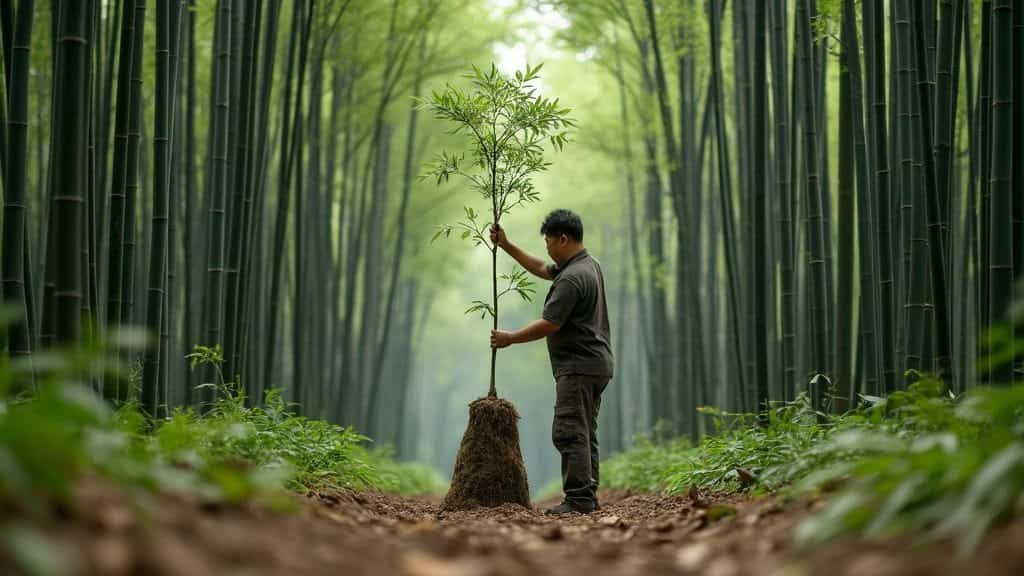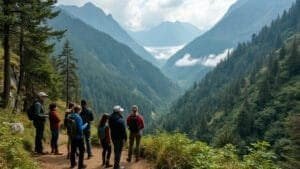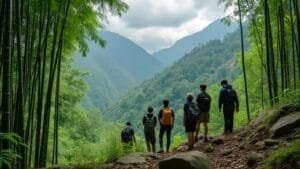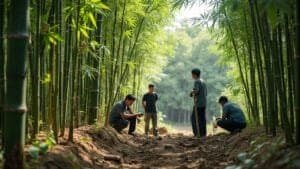Local communities are at the heart of red panda conservation efforts across the Eastern Himalayas. These communities not only share the landscape with red pandas but also play a vital role in ensuring their protection. From patrolling forests and restoring habitats to engaging in eco-friendly enterprises and educating future generations, their involvement has transformed conservation from a top-down effort into a grassroots movement
In this article, we explore the many ways local communities participate in red panda conservation. We’ll cover forest monitoring through the Forest Guardians program, community-led conservation areas, anti-poaching patrols, sustainable livelihood initiatives, and the rising influence of women and youth in protecting this endangered species
Community Roles in Red Panda Conservation

Red panda conservation has undergone a major transformation in recent years, evolving from isolated efforts led by national and international NGOs to a more inclusive and sustainable model that places local communities at its core. This shift recognizes the essential role that people living in or near red panda habitats play in protecting the species. In countries like Nepal, India, and Bhutan, local communities have become active stewards of the forests, contributing to conservation in ways that are both culturally rooted and ecologically effective
The Forest Guardians Program and Its Impact
Among the most innovative and successful community-based initiatives is the Forest Guardians program developed by the Red Panda Network. Started in 2010 with just 16 participants, this program now employs over 128 trained individuals across more than 90 community forests in Nepal. These guardians are not just symbolic protectors—they are the operational backbone of red panda conservation in regions where government enforcement is sparse or inaccessible
Forest Guardians are typically members of local communities who undergo rigorous training in wildlife monitoring, forest ecology, and anti-poaching tactics. They patrol designated red panda habitats on foot, using GPS units, notebooks, and sometimes camera traps to document red panda sightings, signs of illegal activity (like snares or traps), and indicators of habitat degradation. Their data is critical to national conservation efforts, feeding directly into biodiversity mapping and long-term red panda monitoring systems
Beyond data collection, these guardians act as conservation ambassadors in their villages. They conduct educational sessions, lead awareness campaigns during events like International Red Panda Day, and advise their neighbors on sustainable resource use. Because they are trusted members of the community, their messages are more likely to be embraced, especially in rural regions where external conservationists may face cultural or language barriers
The financial support that Forest Guardians receive through their employment also boosts local economies. By earning a steady income, they reduce their dependence on harmful practices like firewood collection or wildlife trade, creating a positive feedback loop between conservation and community well-being
Community-Driven Conservation Area Management
In addition to forest patrols, local communities have taken a leadership role in managing formal conservation areas. A standout example is the Puwamajhuwa Community Red Panda Conservation Area, established in eastern Nepal with guidance from the Red Panda Network and support from Rainforest Trust. Covering over 116 hectares, this area is entirely managed by local forest user groups and community conservation committees
These groups are responsible for everything from habitat maintenance and boundary enforcement to organizing education events and coordinating with national park authorities. Their management plans are developed collaboratively, taking into account both conservation goals and local livelihood needs. For example, community members determine how much bamboo can be harvested annually for non-commercial use and where replanting efforts should be concentrated
Such areas often become biodiversity hotspots, as the community’s efforts to protect red pandas also benefit other threatened species like Himalayan black bears, clouded leopards, and rare pheasants. The creation of these areas has also encouraged other villages to pursue similar initiatives, leading to the growth of connected habitats and wildlife corridors across red panda range countries
The strength of this model lies in its emphasis on local ownership. When conservation areas are defined, monitored, and managed by the people who live closest to them, enforcement is more consistent, ecological knowledge is more precise, and cultural sensitivity is maintained. Over time, this fosters a conservation ethic that becomes embedded in local identity and governance
To explore how the PIT corridor and other community-protected zones are reshaping red panda conservation, the Red Panda Network’s conservation strategy page offers detailed insight into how grassroots management is restoring critical habitat
Sustainable Living and Environmental Education

Red panda conservation doesn’t just happen in the forests—it begins in homes, schools, and village meetings. Beyond protecting habitats and reducing threats, conservation programs aim to transform how communities live, work, and learn in the landscapes they share with red pandas. This means offering sustainable livelihood options, reducing forest dependency, and building a culture of conservation through formal and informal education. These efforts ensure that local participation is not only reactive but proactive—embedded in the daily lives and long-term visions of the people involved
Alternative Livelihoods and Forest-Friendly Economies
One of the greatest challenges in regions where red pandas live is the reliance on forest resources for daily survival. Firewood collection, livestock grazing, and small-scale timber harvesting are necessary for many families, but they also contribute to habitat loss and degradation. Conservation organizations like the Red Panda Network have tackled this challenge by developing alternative livelihood programs that provide economic incentives to protect rather than exploit the forest
In eastern Nepal, for example, communities are trained to produce bio-briquettes made from agricultural waste, which serve as a clean, sustainable alternative to firewood. RPN also supports improved cookstove distribution—fuel-efficient stoves that use less wood and emit less smoke, improving both forest health and household air quality
Eco-tourism is another important initiative. In red panda range areas, trained local guides lead trekking groups in search of red pandas, generating income while promoting awareness and appreciation for wildlife. Guesthouses, cultural craft cooperatives, and community-run lodges benefit from this model, linking economic success to environmental preservation
Handicrafts made from sustainably harvested materials such as nettle fiber are also gaining popularity. Women, in particular, have been empowered through training programs that help them produce and market eco-friendly products. These enterprises not only create income but also help local communities take pride in their biodiversity and cultural heritage
As these alternative livelihoods take root, they help reduce the drivers of habitat destruction while aligning local prosperity with conservation goals. The result is a more resilient economy that supports rather than threatens red panda populations
Environmental Education and Youth Engagement
Education is a cornerstone of long-term conservation success, and red panda programs increasingly prioritize both formal and informal learning opportunities. In schools across red panda range areas, conservation organizations have helped integrate environmental topics into the curriculum. Teachers receive resource packs that include lesson plans, posters, red panda fact sheets, and conservation games designed for students of different ages
Beyond the classroom, education efforts reach adults through village outreach sessions, film screenings, and forest walks led by Forest Guardians. These activities demystify conservation goals, correct misconceptions about red pandas, and offer practical tips on how community members can support habitat preservation in their daily routines
In Nepal, RPN has established dozens of school-based “Roots & Shoots” youth clubs focused on environmental action. These clubs engage young people in tree planting, waste management, wildlife monitoring, and advocacy. Students often go on to become conservation leaders in their communities, helping bridge generational gaps in forest stewardship
The inclusion of youth in conservation builds a future where red panda protection is woven into local identity and cultural values. It also empowers young people to envision careers in wildlife science, eco-tourism, and sustainable development—fields that are not only beneficial to red pandas but also vital to regional growth
For a real-world example of how livelihoods and education intersect with conservation, Rainforest Trust’s project page on the Red Panda Community Forest illustrates how local participation and legal protection work together to sustain ecosystems and economies
Community Decision-Making and Conservation Outcomes

A truly sustainable conservation program does more than just invite community participation—it integrates local voices into governance, decision-making, and long-term planning. Red panda conservation efforts across the Eastern Himalayas are increasingly adopting this inclusive model, where communities aren’t simply partners—they are leaders. By empowering villages to shape forest policies, manage resources, and receive direct benefits from conservation, these programs foster a deeper, more lasting commitment to protecting biodiversity
Local Influence on Forest and Land Use Policies
Community Forest User Groups (CFUGs) play a vital role in red panda habitat management, particularly in Nepal, where over 40% of forests are managed by local communities. These groups develop and enforce their own forest management plans, which outline how land and resources can be used sustainably while protecting wildlife
Through these plans, communities determine which areas are open for limited use (such as firewood collection or grazing) and which should be strictly protected due to their importance for red pandas or other species. They also designate zones for reforestation, erosion control, and eco-tourism. These policies are created through participatory meetings and are typically reviewed annually to ensure ecological and economic needs are being met
Community decisions extend beyond forest zoning. In many cases, CFUGs influence district-level conservation policies by representing local interests in multi-stakeholder forums. Their firsthand knowledge of local ecosystems and cultural practices often makes their insights more practical and effective than top-down mandates
By incorporating Indigenous knowledge, these community-led governance systems also preserve traditional ecological practices, such as selective harvesting, seasonal grazing, and sacred forest protection—all of which contribute to red panda conservation while maintaining cultural continuity
Academic studies, including recent findings published in Land Use Policy, have shown that forests under community management often perform better in terms of biodiversity conservation and resource sustainability than state-managed forests. This underscores the critical role of empowered local governance in achieving lasting conservation outcomes
Socioeconomic Benefits of Community-Led Conservation
Conservation programs that include communities as stakeholders don’t just help red pandas—they improve human well-being too. One of the clearest benefits is increased household income. Through paid roles as Forest Guardians, guides, nursery managers, and artisans, local families gain access to new revenue streams that are directly tied to forest health
Healthcare and education services also improve in areas where conservation groups operate. In Nepal, the Red Panda Network has supported mobile health clinics, distributed clean energy stoves, and provided scholarships for students from conservation-focused families. These efforts help meet basic needs, making conservation not just a moral issue, but a practical and beneficial one for everyday life
Empowering women in these efforts adds another layer of resilience. When women participate in forest management committees, restoration work, and conservation business ventures, families tend to invest more in education and long-term planning. This inclusive approach not only strengthens community cohesion but also helps scale conservation impacts more broadly
Culturally, participation in red panda conservation fosters pride and environmental identity. Celebrations like International Red Panda Day or local tree-planting festivals turn conservation into a community event—something that is celebrated, not just enforced. This shift in perspective is what transforms conservation from an external intervention to an internalized value
To learn more about how community ownership builds lasting conservation gains, WWF’s report on community involvement in red panda protection explores how incentive-based strategies and local stewardship are reshaping the future of red panda habitats











